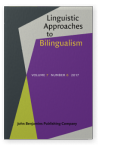Commentary
Interpreting age effects in language acquisition and attrition
References (9)
References
Bylund, E. (2009). Maturational constraints and first language attrition. Language Learning, 59(3), 687–715. 

Bylund, E. (in press). Age effects in language attrition. In M. S. Schmid & B. Köpke (Eds.), The Oxford handbook of language attrition. Oxford: Oxford University Press.
Hyltenstam, K., Bylund, E., Abrahamsson, N., & Park, H. -S. (2009). Dominant-language replacement: The case of international adoptees. Bilingualism: Language and Cognition, 12(2), 121–140. 

MacWhinney, B. (2012). The logic of the unified model. In S. M. Gass & A. Mackey (Eds.), The Routledge handbook of second language acquisition (pp. 211–227). New York: Routledge.
Norrman, G., & Bylund, E. (2016). The irreversibility of sensitive period effects in language development: evidence from second language acquisition in international adoptees. Developmental Science, 19(3), 513–520. 

Polinsky, M. (2006). Incomplete acquisition: American Russian. Journal of Slavic Linguistics, 141, 191–262.
Schmid, M. S. (2011). Language attrition. Cambridge: Cambridge University Press. 

Schmid, M. S., & Köpke, B. The relevance of language attrition to theories of bilingual development. Linguistic Approaches to Bilingualism.
Cited by (1)
Cited by one other publication
Wang, Yi & Li Wei
2022.
Thinking and Speaking in a Second Language,

This list is based on CrossRef data as of 5 july 2024. Please note that it may not be complete. Sources presented here have been supplied by the respective publishers.
Any errors therein should be reported to them.
